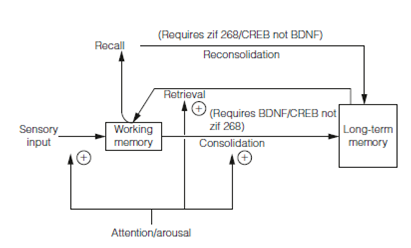Consolidation and reconsolidation
Consolidation is the procedure which makes both procedural and declarative memories increasingly resistant to disruption or interference from same learning over time. Serial models postulate which elements may be selected from working memory for consolidation into LTM through arousal and attention mechanisms. Experiments in which animals are injected shortly after training on a novel task with antibiotics that inhibit protein synthesis for instance anisomycin, cyclohexamide shows which consolidation requires protein synthesis.
In at least some cases recalling a consolidated memory returns it to a labile state in which it becomes sensitive to interference. This is where a previously established memory can no longer be retrieved because of competition from new learning. To prevent this, the recalled memory must now be reconsolidated. For example, if established auditory fear memories are reactivated in rats the protein synthesis is needs for the memory to be retained. The biochemistry of consolidation and reconsolidation appear to be different in below Figure.

Figure: Possible functional relationships between working memory and long-term memory. Consolidation and reconsolidation are biochemically dissociable. BDNF, brain-derived neurotrophic factor; CREB, cyclic AMP response element binding protein; zif 268 (Egrl), zinc finger transcription factor 268 (Early growth response protein I).